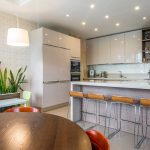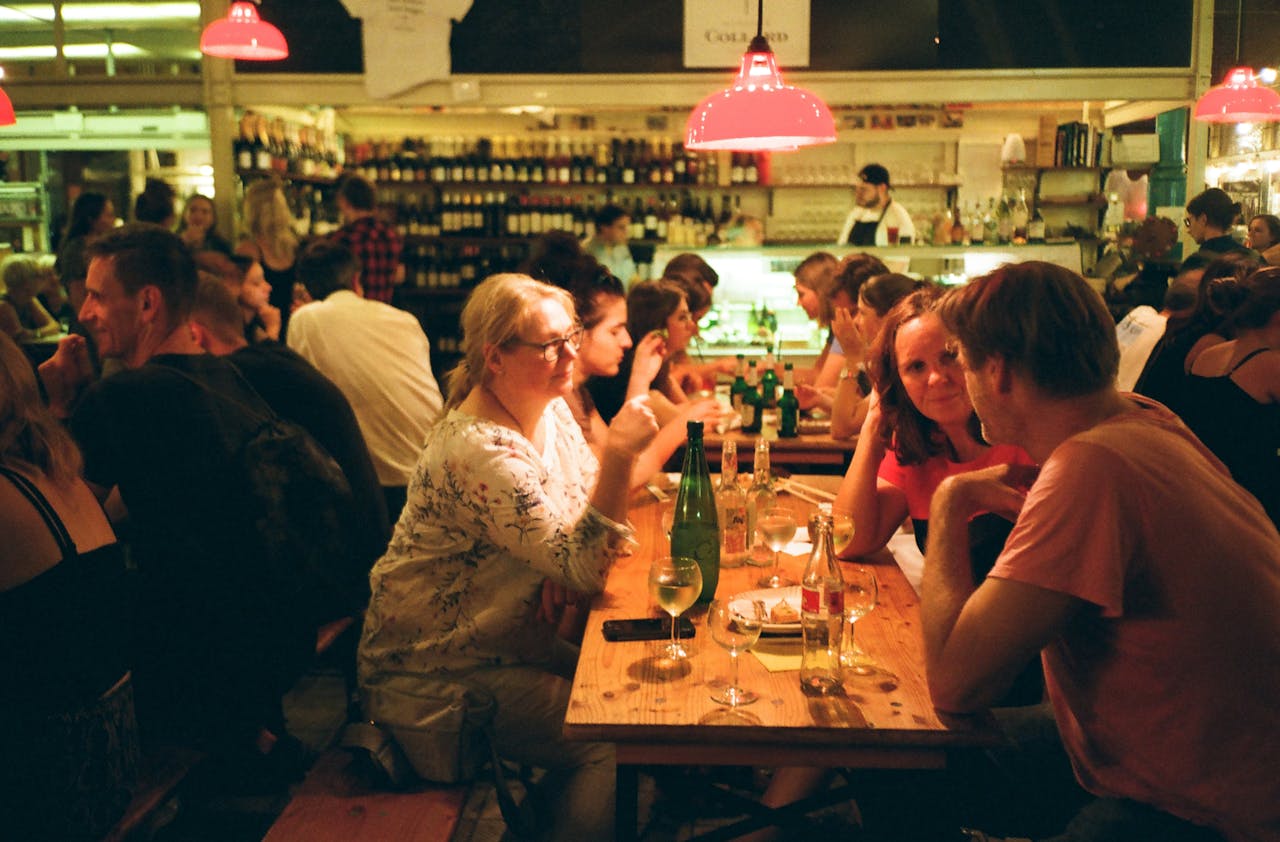In the rapidly transforming world of bar and restaurant design, lighting has established itself as a vital component in creating an ambiance that appeals to customers. Not only does it contribute to a welcoming atmosphere, it also serves a practical purpose. However, with the rising emphasis on sustainability and energy conservation, how can businesses strike the perfect balance? The answer is simple: uplighting. By implementing LED uplighting, bars can create a unique ambiance without significantly raising energy costs. This article explores the utilization of uplighting in bars, its influence on customer experience, and its potential for energy savings.
Leveraging Uplighting in Bar Design
Uplighting, a type of accent lighting, is the strategic placement of light fixtures towards the ceiling or upper parts of a room, creating a dramatic and elevated mood. This method of lighting is especially effective in bars, where creating a unique and intimate experience for customers is paramount.
Topic to read : What are key considerations for designing a wheelchair-accessible restaurant?
LED lights are the most common choice for uplighting, as they are energy-efficient, durable, and offer control over color and intensity. LED uplighting can be used to highlight architectural features, create focal points, or simply to add layer and depth to the overall bar lighting design.
By choosing LED uplighting, bars can create a dynamic, multi-dimensional space that not only ensures the comfort of their customers but also contributes to a sustainable future.
Topic to read : What is the best method to train restaurant staff on allergen awareness?
Influencing Customer Experience Through Lighting
Lighting has a profound impact on a customer’s dining experience. The right lighting can enhance the mood, influence perception of space, and even affect the taste of food and drinks.
Uplighting allows bars to control the mood and ambiance of their space. With LEDs, bars can easily adjust lighting levels to match the time of day, complement the music, or even align with special events.
Furthermore, the placement of uplighting can make a room appear taller and more spacious, creating an illusion of a larger space. This can be particularly beneficial for smaller bars that want to maximize their space utilization.
The ability to create various moods and atmospheres with uplighting can deeply influence a customer’s experience, making their visit to your bar a memorable one.
The Energy-Efficient Nature of LED Uplighting
In a world where sustainability is increasingly important, bars and restaurants need to pay close attention to their energy consumption. Luckily, LED uplighting provides a way to create stunning light effects without a high energy cost.
LED lights are up to 80% more efficient than traditional lighting such as fluorescent and incandescent lights. Most of the energy in LEDs is converted into light, not heat, which means less energy is wasted. They also have a longer lifespan, reducing the need for frequent replacement and consequently, waste.
By switching to LED uplighting, bars can significantly reduce their energy bills, making it a cost-effective solution for creating a captivating ambiance.
The Importance of Lighting Control in Bars
Control is a key aspect of any lighting design. With the advent of smart lighting technology, bars have the ability to control the intensity, color, and even direction of their uplighting.
This gives bars a greater degree of flexibility and creativity in creating their desired ambiance. It also allows for the conservation of energy. For instance, during the day when natural light is abundant, the lighting system can be adjusted to consume less energy.
Lighting control systems can be programmed to change lighting scenarios automatically at different times of the day, creating different moods and atmospheres, and further enhancing the customer experience.
Combining Ambient, Accent, and Mood Lighting
While uplighting is a form of accent lighting, it works best when combined with other types of lighting to create a comfortable and inviting atmosphere.
Ambient lighting provides the overall illumination of the space. It is the base layer upon which other lighting layers are added. It should be bright enough to allow customers and staff to move around safely, but not so bright that it eliminates the cozy and intimate feel a bar should have.
Accent lighting, such as uplighting, is used to highlight specific areas or features. It can be used to draw attention to artwork, architectural details, or the bar itself.
Mood lighting, on the other hand, is used to create a certain atmosphere or evoke specific emotions. It often involves the use of color and dynamic light effects.
By combining these different types of lighting, bars can create a complete lighting design that enhances the customer experience while remaining energy-efficient.
The Integration of Different Types of Lighting in Bar Design
While the use of uplighting significantly contributes to the ambiance, it isn’t the only type of lighting used in bars. In fact, a thoroughly designed lighting plan incorporates a blend of different lighting types, including ambient, accent, and task lighting, each serving a specific purpose.
Ambient lighting sets the overall illumination in a bar. It’s the foundational light layer that provides sufficient brightness for safety and navigation. Pendant lights, recessed lighting, and track lighting are some of the fixtures commonly used for ambient lighting.
Task lighting, as its name suggests, is designed to help staff and customers perform specific tasks, such as reading menus or mixing drinks. It’s crucial in areas where precision and clarity are needed, such as the bar counter and kitchen.
Finally, accent lighting adds depth and dimension to the space. This is where uplighting comes into play, focusing light upwards to highlight architectural features, artwork, or anything else worth showcasing. LED strips are often used in this context because they offer control over color and intensity, allowing for constant adaptation to the mood or theme of the evening.
The integration of these lighting types in a harmonious and balanced manner is essential in bar design. It allows for a dynamic, multi-dimensional space that caters to both the functional needs and the emotional experience of customers.
Harnessing the Power of LED Lights in Restaurant Lighting
A key player in the uplighting game, and in restaurant lighting in general, is the LED light. LED lights have multiple advantages that make them an ideal choice for bars and restaurants striving to balance ambiance and energy efficiency.
One of the main advantages is their energy efficiency. LEDs convert almost all their energy into light, with very little wasted as heat. This makes them significantly more energy-efficient than traditional lighting options like incandescent or fluorescent lights.
Moreover, LEDs have a longer lifespan, which means less frequent replacements and, consequently, less waste. They are also highly durable, able to withstand harsh conditions without losing their effectiveness.
Another advantage is the control they offer over lighting parameters. With LEDs, you can easily adjust color, intensity, and even direction, making it possible to create a wide array of moods and atmospheres. This attribute is especially valuable in the context of uplighting, where the aim is to evoke certain emotions and create unique dining experiences.
In short, LED lights are an essential part of sustainable, cost-effective, and creative restaurant lighting.
Conclusion
In conclusion, uplighting, when incorporated thoughtfully, can significantly enhance the ambiance of a bar without escalating energy costs. By leveraging the efficiency and versatility of LED lights, bars can create a variety of moods and experiences that appeal to customers. The blend of ambient, task, and accent lighting creates a dynamic environment that’s both visually engaging and functional.
As the world continues to transition towards sustainability, the importance of energy-efficient solutions like LED lighting cannot be overstated. As such, bars and restaurants should consider incorporating LED uplighting – not just for its aesthetic benefits, but for its contribution to sustainable practices and reduced energy costs. Lighting, when done right, can create an unforgettable dining experience while keeping an eye on the ever-important bottom line.






